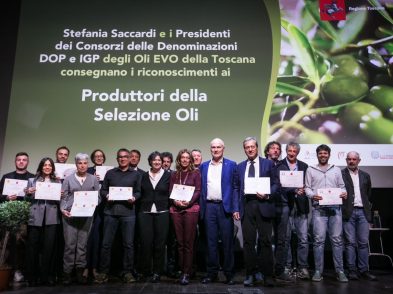Our
jeep bounced up the white track, wheels spinning on loose pebbles. Below, the
Montalcino-Buonconvento road disappeared in the morning mist. ‘Can this be the
right place? Where’s the music?’ wondered my partner, David. Then, up ahead, we
caught a glimpse of Carlo Cignozzi, the wine producer we had come to interview.
He was leading a group of tourists into a vineyard perched on the hillside.
From his animated gestures and the attentive circle gathered around him, it was
clear that he already had his audience entranced. I rolled down the car window
and the notes of Mozart’s 23rd piano concerto drifted into our ears.
David
and I have lived in Montalcino off and on for four years, drinking in the
Tuscan air, culture, warm friendship of our neighbours and, of course, the
wonderful wine. We are far from being oenological experts, but we have been
slowly exploring some of the more than 200 vineyards and farms in Montalcino
that grow the Sangiovese grape, producing Brunello di Montalcino and its ‘baby
brother,’ Rosso di Montalcino, as well as other local wines. Our learning curve
is almost as steep as the white roads we struggle up to reach vineyards high
among oak woods and hills around our beautiful town.
As
many readers will be aware, Brunello di Montalcino is made according to strict
rules, monitored more carefully than ever since the ‘Brunello-gate’ scandal of
2008 (see TF 77). However, it seems that every producer in Montalcino has his
or her own particular take on what makes for the perfect Brunello.
In
Cignozzi’s case, it is something rather unusual. He has deployed 62 Bose
speakers in and around the vineyard at Paradiso di Frassina and maintains that
constant exposure to Mozart’s works (played 24 hours day, on a 60-hour tape
loop), will improve the grapes and ultimately, the wine.
Having
waved off the satisfied coach party, Cignozzi gave us a brief history of the
Mozart experiment. He must tell this story almost every day of his life. He has
also written a book on the topic, L’uomo che sussura alle vigne (roughly, ‘the vine whisperer’). Yet his enthusiasm seems undimmed as he
recounts how he arrived here in 1999, found the ruined farmhouse with its few
rows of ancient vines, and decided to swap a successful career as a Milanese
lawyer for a very different project. Cignozzi’s eyes lit up as he described his
‘road to Damascus’ moment. Turning the final bend in the old track (‘much less
easy than it is now, not even a white road!’), he opened the car window and a
Mozart concerto, coincidentally playing on the car radio, rolled out across the
countryside. ‘And I thought, I must do this, I must bring music here.’
Cignozzi
believes that music-especially at low frequencies-can have a mantra-like effect
on human beings, ‘and we forget the animals and the plants, why?’ It was hard
to tell which came first, the feeling, or the theory. He offers a bewildering
array of examples, such as how French friars in the Middle Ages placed cow
stalls near the choir stalls ‘because with Gregorian chant, the cows made more
and better milk.’ He links the idea to Fibonacci’s chaos theory and ‘la
mathematica della natura.’ Seemingly, at Paradiso di Frassina it all works
through vibrations that travel through air and earth, reaching every part of the
vine.
As
we walked and talked, Cignozzi explained how the project has grown from a
modest original investment in 12 speakers to the current experiment supported
financially by an Indian American professor, Amar Gopal Bose, founder and
president of the Bose Corporation, who had seen Cignozzi on TV. ‘God bless
Indian people! No one else had touched his heart in this way.’
So
what are Cignozzi’s main claims? First, he believes that with musical
accompaniment the leaves and plants grow ‘greener, stronger, bigger.’ He is
convinced that the sugar and polyphenol content and acidity of the grapes are
improved. He also finds that insects, birds and even wild boar are repelled,
‘Sometimes you can see them all over there, in my other field!’
With
interest flowing in from around the world, the universities of Florence and
Pisa became involved, setting up research into the possible ‘physical’ and
‘entomological’ effects of Mozart on the vines. Cignozzi showed us some of the
controls in place, for instance, an area where the music is quieter or can
barely be heard as well as the use of insect traps monitoring the effects on
pests. Recently his work as a biodynamic producer has been featured in The
Bright Green Book, a United Nations committee report on ‘greening the world.’
Producers from other countries are interested, as well. He mentioned Brazil and
Switzerland, ‘but we need the research results first.’ As a former lawyer, he
is cautious about Bose’s idea of patenting his methods: ‘Are you crazy?’ he
once told his financier. But clearly, the interest created both by the
experiment and by Cignozzi’s ability to convey his ideas and enthusiasm can
only aid the success of the vineyard.
Research
results are due out later this year. If the proof of the whole project is in the
wine, well, Cignozzi is certainly not alone in this in the grape-growing
capital of Montalcino. But he does make a gorgeous biodynamic Brunello.
I
asked a few more challenging questions: Doesn’t the 24-hour Mozart diet
sometimes drive him and his workers mad? How does he sleep? He laughed
ruefully, ‘Once they did say to me, Carlo, basta! So, I changed the
tape.’




